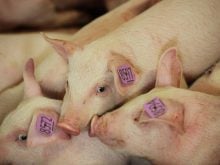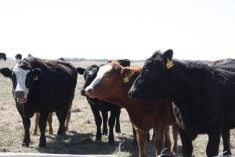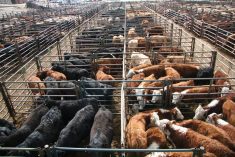RENO, Nev. — If one child dies from hamburger disease it’s one too many.
That statement is part of the American beef industry’s strategy to stop the spread of potentially fatal E. coli bacteria found in improperly cooked hamburger. The strategy will be known as zero tolerance.
Russell Cross, administrator of the federal food safety and inspection service in Washington, said the meat industry has fallen short when it comes to controlling food-borne pathogens. The meat and poultry industries must be held accountable to the public which eats their product, he told the National Cattlemen’s Association.
Read Also

Canada told trade crisis solutions in its hands
Canadians and Canadian exporters need to accept that the old rules of trade are over, and open access to the U.S. market may also be over, says the chief financial correspondent for CTV News.
The industry has done a good job cleaning up pesticide and drug residues but eradicating bacteria that cause food poisoning is still a serious problem, he said.
About 2,000 Americans die each year from food poisoning, he said. Scientists are not positive where these fatal bacteria come from but are assuming they are harbored in fecal material left on hides. Traces of manure can then end up on a skinned carcass. Up to now any traces of feces have been cut away.
As part of the zero tolerance program, a new inspection system was introduced to ensure clean meat is coming out of slaughter houses. Secretary of agriculture Mike Espy is insisting this program be in place in all federally inspected plants immediately.
Meat scientist Gary Smith of Colorado State is leading a research team to investigate whether washing carcasses in slaughter plants is a more effective way to kill bacteria compared to trimming.
They found washing carcasses with water at 300 to 400 pounds of pressure at 90¡ Fahrenheit removes most bacteria. They are also checking to see if acids or other additives in the wash will make carcasses even cleaner.
Australia is also experimenting with carcass washes and has found organic acids or very hot water of 188¡ F. is effective in removing bacteria.
The three main packers of IBP, Montfort-ConAgra and Excel are participating in the washing study in plants in Colorado, Texas, Kansas and Wisconsin.
Undercooking a problem
Besides slaughter plants another source of infection occurs in fast food restaurants where hamburger is undercooked.
E.coli dies when cooked at 155¡ Fahrenheit. Studies have shown many grills in restaurants have varied temperatures on the cooking surface of 128¡ to 182¡ F. Up to one-third of hamburgers aren’t being cooked properly. An important step in the battle against hamburger disease will be to check grills and close the temperature gap.
Another problem is at home where there are no controls over cooking and cleanliness, said Cross.

















